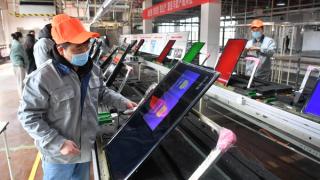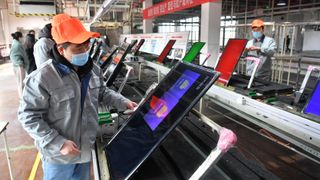If one needed further evidence that the Chinese Communist Party still doesn’t understand how open societies work, look to ambassador Cheng Jingye’s comments that Chinese consumers might boycott Australian exports if the Morrison government continues to push for an international inquiry into the origins and early spread of COVID-19.
While an angry misstep is one thing, Beijing surely must realise these threats will only fuel an Australian and global conversation already occurring among the advanced democracies about the need for greater economic distance from China.

The CCP continues to condemn such talk as xenophobic and racist, as it would prefer the world to return to business as usual with China once the pandemic passes. That is hardly surprising given Beijing was getting away with mercantilist trade and investment practices and industrial-scale intellectual-property theft, and benefiting from good access to international technology and innovation without offering the same in return.
Cheng’s warnings reveal the vengeful, angry and insecure nature of the CCP and give credibility to the argument that some economic separation from China is more important now than it was in the pre-COVID-19 world.
Where possible, gradual diversification of exports is one sensible suggestion. But what does economic distancing look like when the dust settles, and what aspects of Donald Trump’s economic war with China should Australia encourage and even support?
Securing supply
Last last year, the US and Australia signed a deal to better secure future supplies of critical minerals, especially rare-earth metals used in a wide range of applications, from iPhones and lasers to rechargeable batteries and hybrid vehicles. One clear aim is to reduce dependency on China, which supplies about 85 per cent of the market. COVID-19 has highlighted the unacceptable reliance on China for medical and pharmaceutical devices and products.
COVID-19 has highlighted the unacceptable reliance on China for medical and pharmaceutical devices and products.
As the conversation about national resilience and self-sufficiency grows, it is certain the list of products and sectors identified as critical will expand. This will be accompanied by agreements to source these from reliable and friendly countries and reduce dependency on China.
What about one stated aim of the Trump administration, which is to move manufacturing supply chains away from China?
The bad news for those seeking a significant reduction in the prevalence of “Made in China” products in our lives is that they will be disappointed. While many traditional and current-generation merchandise brands are American, European and Japanese, rather than Chinese, it will be difficult for any government to persuade them to relocate supply chains away from China and back to home base.
Indeed, the trend of supply chains for traditional and current-generation goods becoming more centred in our region will remain. China’s huge footprint in exports is reflected in the estimate that it accounts for about 35 per cent of global manufacturing but only 10 per cent of global household consumption. And its dominance in traditional manufacturing is helped by the rapid pace of progress in manufacturing-related technologies such as robotics, automation, artificial intelligence and 3D printing. These technologies increase incentives to locate production and assembly of merchandise goods closer to the end consumer or user — in this case, Australia and most of our Asian trading partners.
Furthermore, the difficulty of US and other firms quickly shifting supply chains out of China, which has become the central hub for parts and assembly, should not be underestimated.
While many traditional and current-generation merchandise brands are American, European and Japanese, rather than Chinese, it will be difficult for any government to persuade them to relocate supply chains away from China and back to home base.
The example of Taiwanese firm Foxconn, which makes iPhones, is instructive. Foxconn is reliant on China’s excellent manufacturing and transport infrastructure and draws on a network of more than 1500 Chinese suppliers. In 2018, the company produced about 220 million smartphones to sell to the world. Other prospective production centres such as Vietnam and India are not comparable substitutes in the foreseeable future.
Incidentally, it is estimated there are 51,000 international companies with one or more direct suppliers from Wuhan, where COVID-19 came from, while more than five million companies have one or more tier-two suppliers in that region.
One should also bear in mind that in the short term, and possibly longer, the effects of COVID-19 in alternative manufacturing centres such as Vietnam, Thailand, Bangladesh and India are uncertain. If China can manage and contain infections in key manufacturing provinces, it might be far too risky for firms to shift operations out of China into economies still afflicted with COVID-19. In any event, and even when combined, these countries cannot replicate the scale and synergies that one can find in China. The bottom line is that substantially reducing the Chinese presence in regional and global supply chains for non-critical merchandise products is simply not feasible.
In May 2015, the Chinese State Council launched Made in China 2025 to guide the upgrading of Chinese industry, production and innovation across the next 10 years. The blueprint seeks control over, and dominance of, entire manufacturing processes, supply chains and associated services for sectors identified in the MIC 2025 plan. These include new-generation information technology, advanced numerical control machine tools and robotics, aerospace technology, biopharmaceuticals and medical equipment.
Ambitious expansion
MIC 2025 will co-opt and force indigenous private firms to ensure that value creation is created in and retained within China. All state-controlled and private indigenous firms are potential partners and participants in MIC 2025, and those advancing the blueprint’s objectives will be offered financial, regulatory, legal and political support and assistance.
MIC 2025 is also much more ambitious and muscular in its outward-focused end goals than previous blueprints. Its objective is not simply to ensure China becomes an advanced and competitive economy. The measures are explicitly designed to create the foundation for Chinese firms to dominate these sectors in global markets.
Made in China 2025 is explicitly designed to create the foundation for Chinese firms to dominate these sectors in global markets.
China is also to become a global hub for firms in these sectors. This will allow its economy to host, absorb and localise entire supply chains, intellectual property and related services. These sectors will drive the creation of future value and, by extension, the accumulation of national power.
How is China doing? To achieve its objectives, it needs to meet four broad conditions: investment at scale; access to large and advanced markets; an effective system to drive innovation and competition; and channels to develop and/or acquire technology and know-how.
Beijing’s state-led approach and economic size clearly fulfils the first condition. However, meeting the other three is far more problematic. This is where the US and its partners have the advantage. Pressing it means denying or restricting Chinese firms’ access to capital, markets and know-how in these hi-tech and high-value sectors. Chinese firms need to succeed in the US and Europe to become global champions. The diversity and depth of the US financial and capital markets, as well as the dominance of the greenback as a reserve currency and to transact with, mean Washington has powerful tools at its disposal.
For Australia, the banning of Huawei from the 5G rollout is just an early taste of the emerging battleground and the difficult decisions ahead. In particular, the US will be eager to restrict or eliminate technological or know-how leakage to China in these sectors.
As in Australia, the US has expanded executive powers to block corporate and sales transactions, and a growing number of Chinese firms in MIC2025 sectors will inevitably be included on the “restricted entity” list. Through the Australian Foreign Investment Review Board and the “national interest” provision available to the Treasurer, one would expect heightened scrutiny of Chinese transactions that relate specifically to MIC 2025 given what is at stake. Despite Canberra’s preference for an ostensibly non-discriminatory direct foreign investment regime, there must be different rules for Chinese firms, because the Chinese political economy operates very differently to anything else.
Despite Canberra’s preference for an ostensibly non-discriminatory direct foreign investment regime, there must be different rules for Chinese firms, because the Chinese political economy operates very differently to anything else.
The bad news for our universities is that there is a strong case for increasingly co-ordinated allied policy relating to restrictions on visas for Chinese researchers and tertiary students in sensitive sectors. Such restrictions will also apply to joint research projects with Chinese entities and experts. Beijing has long carried out a systematic program to acquire expertise and know-how from nations such as the US and Australia to advance industrial plans such as MIC 2025 and enhance its military capabilities under its comprehensive civilian-military fusion policy.
Self-regarding
Despite much attention focused on the disruptive approaches of the Trump administration, China remains far more restrictive and self-regarding when it comes to its policies on industry, market access, innovation and the exchange of people and ideas.
It is the CCP that has long been seeking to strike an unequal and unfair bargain with other countries when it comes to the former’s participation in the global economic system. In its Leninist world view, which has been reinforced and advanced under Xi Jinping, all public and private activities can be deployed to serve the objectives of the party and state. This includes all economic activity and how technology is acquired and used.
Even so, one should avoid ill-considered efforts to economically distance from China, which will prove unnecessary, self-defeating or else impossible. The greater the impact of the technology or commercial activity on national power and capability, the more we need to compete, because we can be sure Beijing is already doing just that.
Best to play on that ground, which also happens to be where the US and its allies still hold a competitive advantage.






